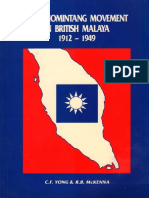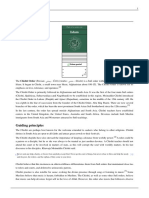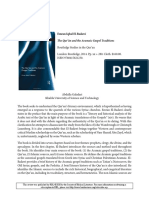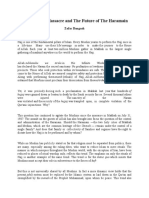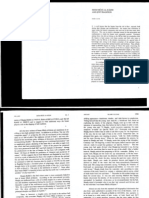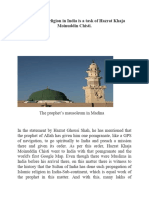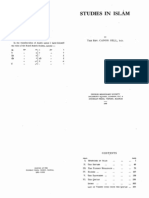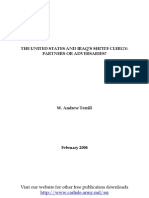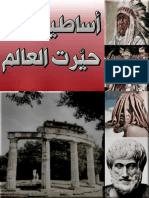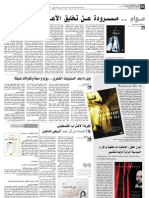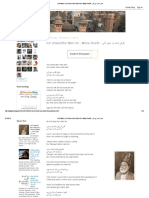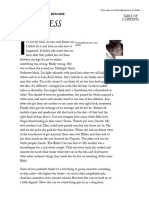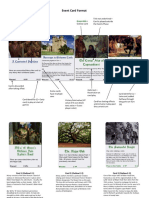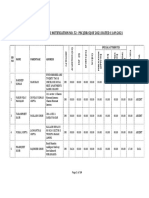Social and Economic Conditions in Pre-Islamic Mecca
Social and Economic Conditions in Pre-Islamic Mecca
Uploaded by
Nefzawi99Copyright:
Available Formats
Social and Economic Conditions in Pre-Islamic Mecca
Social and Economic Conditions in Pre-Islamic Mecca
Uploaded by
Nefzawi99Original Description:
Copyright
Available Formats
Share this document
Did you find this document useful?
Is this content inappropriate?
Copyright:
Available Formats
Social and Economic Conditions in Pre-Islamic Mecca
Social and Economic Conditions in Pre-Islamic Mecca
Uploaded by
Nefzawi99Copyright:
Available Formats
Social and Economic Conditions in Pre-Islamic Mecca Author(s): Mahmood Ibrahim Reviewed work(s): Source: International Journal of Middle
East Studies, Vol. 14, No. 3 (Aug., 1982), pp. 343-358 Published by: Cambridge University Press Stable URL: http://www.jstor.org/stable/163677 . Accessed: 05/05/2012 05:54
Your use of the JSTOR archive indicates your acceptance of the Terms & Conditions of Use, available at . http://www.jstor.org/page/info/about/policies/terms.jsp JSTOR is a not-for-profit service that helps scholars, researchers, and students discover, use, and build upon a wide range of content in a trusted digital archive. We use information technology and tools to increase productivity and facilitate new forms of scholarship. For more information about JSTOR, please contact support@jstor.org.
Cambridge University Press is collaborating with JSTOR to digitize, preserve and extend access to International Journal of Middle East Studies.
http://www.jstor.org
Int. J. Middle East Stud. 14 (1982), 343-358 Printed in the United States of America
Mahmood Ibrahim
SOCIAL AND ECONOMIC PRE-ISLAMIC MECCA
CONDITIONS
IN
Mecca's existence depended primarily on its location near the most important trade route in western Arabia which linked the surplus-producing region of Yemen with Syria. The route branched near Ayla in the north to proceed to Gaza on the Mediterranean and also to Egypt. Another route branched near Mecca to proceed in a northeasterly direction toward al-Ubulla, Hira, and eventually Sasanid Persia. The commercially advantageous location of Mecca was enhanced further by the Zamzam waterwell which made Mecca a convenient stop in the trade of antiquity. Also the concept of the haram, the sacred area, and its center, the Ka'ba, made Mecca the object of pilgrimage during the sacred months. During these months, pilgrims/merchants traveled with security of life and property and went to Mecca to trade their commodities. Not all tribes in the area believed in the concept of haram; they were referred to as al-muhillun as distinguished from those who adhered to the concept who were known as almuhrimun. Mecca in its early history had no political power to speak of, and it was under the control of the Himyarites in Yemen who endeavored to spread their hegemony over the surplus-producing regions in Arabia such as Najd, Bahrain, and Oman.' Until the beginning of the fifth century A.D. Mecca was controlled by the tribe of Khuzi'ah who had emigrated earlier from Yemen. This tribe was edged out of power when Qusayy ibn Kilab gathered several clans to form the tribe of Quraish who quickly became the leading merchants of the city. Although the Meccans were well situated for the development of a commercial network, they remained secondary to the Himyarites and to the Lakhmids of HTra,both of whom attempted to spread and to maintain their influence over the producing regions of Arabia. Mecca's evolution in its earlier stage thus took place in the shadow of these two leading commercial and political centers. Tha'alibTreported that the Meccans operated only locally, never venturing beyond the haram area, waiting instead for outside merchants to come in and sell their merchandise.2 Only then did the Meccans have anything to trade with the surrounding tribes. This limited exchange, however, was the genesis of merchant capital in Mecca. An indication of this limited exchange was Qusayy's introduction of some governing institutions in Mecca. After he took over sole leadership he built Dar al-Nadwa adjacent to the Ka'ba to be his residence and meeting place for the collective leadership of the Quraishi clans to deliberate. Marriages and other ceremonies also took place there. Some of the institutions started here were:
0 1982 Cambridge University Press 0020-7438/82/030343-16 $2.50
344
Mahmood Ibrahim
hijaba, responsibility for the upkeep of the Ka'ba (wilayat al-bait); siqaya, providing water for the pilgrims; rifada, providing food for the pilgrims, which is to be distinguished from rifada, the taxes collected for incidental purposes such as blood money or covering of the Ka'ba; liwi', the standard of war, reserved for the leading clan chief; and the 'ushr tax, collected mainly from non-Meccan merchants who came to the city.3 Their common characteristic was that they were oriented toward the internal dynamic of Meccan affairs. They were relevant only inside Mecca since at this stage Meccan merchants rarely left the haram to trade. Limited accumulation remained the lot of Meccan merchants until the advent of Hashim ibn 'Abd Manaf ibn Qusayy. The change in Mecca's fortunes was not without its historical relevance. By the middle of the fifth century the Himyarites began to experience a series of internal political crises. Their instability contributed to the disruption of production and trade, especially in the north. This situation encouraged the Meccans to fill the gap created by the departure of the Yemenis. Since the Meccans had no supporting institutions for this new role, they had to devise some to carry them and their capital outside of Mecca. It was at this juncture that Hashim introduced Tlaf,an agreement between the Quraish and the tribes along the trade routes to provide Meccan caravans with safe passage and protection, khafara. The circumstances that immediately preceded the introduction of this important institution are illuminating. Because of the restricted nature of their commercial activity, Meccan merchants were constantly faced with the possibility of financial disaster. Indeed, the Meccans had developed i'tifad (ritual suicide) as a response to this situation.4 When a merchant became bankrupt he committed i'tifad by separating himself and his family from the rest of the clan and starving to death rather than becoming a liability to relatives. Individual commercial ventures at a time of insecurity and poor business led many merchants to disaster and to the disruption of developing merchant capital. The destructive potential of i'tifad was recognized by Hashim. When a member of the Banul Makzuim was about to commit ictifad, Hashim intervened and declared to his fellow Quraishites that i'tifad was about to overtake them, that they were becoming weak and less numerous than the rest of the Arabs (presumably other Arab merchants). As a remedy, Hashim suggested that they form parterships in carrying out their business enterprises.5 The partnership, mu.daraba, allowed many merchants to pool their capital and form one huge caravan that provided security for the small investor and mobilized Meccan merchant capital on an unprecedented scale when those undertakings could be accommodated in the wider commercial exchange of western Asia. Having changed the organizational nature of merchant capital, Hashim set out to secure an outlet for it. This was accomplished by the institution of the ilaf. The ilf, as defined earlier, was an agreement between the Quraish and the tribal chiefs who lived along the trade routes that emanated from Mecca. In return for safe passage and armed protection, khafara, the Quraish promised to carry and sell tribal products in the markets they visited. The Meccans would then return the investment and the profit to the tribal leader.6 The Tlaf,therefore, not only helped Meccan trade by providing mobility for its capital and by
Social and Economic Conditions
345
leaving caravan travel unmolested, it also encouraged development of the tribal economy by assuring a market for its products. A significant outcome of this arrangement was integration of the tribal economy within Mecca's economic framework which enhanced the influence and prestige of the Quraish among the surrounding tribes. This relationship played an active role in attracting merchants and settlers to Mecca to participate in its developing economy. Hashim was able to secure the ilaf with tribal chiefs along the trade route to Syria where he met with Byzantine leaders and convinced them that it was in their best interest to deal with the Quraish, tujjar al-'arab. Hashim argued that their cloth and leather was cheaper and of a better quality than that of others.7 He was undoubtedly referring to fine leather from Ta'if and from surrounding tribes. Cloth was produced in great quantity in various cities in Yemen, especially Najran and San'a. Yemen also exported fine leather which was produced in several localities, especially Sacda. Hashim then secured safe passage in Syria for Meccan merchants who began to visit Egyptian and Syrian marketplaces such as Gaza (where Hashim eventually died) and Busra where wheat from the Hawran district was Mecca's principal import. The precedent set by Hashim was followed by his brothers. Nawfal opened the road to Iraq (he died in the vicinity of HTraon one of his business journeys), 'Abd Shams developed the trade with Abyssinia, and 'Abd al-Muttalib with Yemen. Meccan merchants were also known to hire ships to carry their trade in the Red Sea and beyond. Hashim's innovative approach gave Meccan merchant capital more mobility and Meccans the opportunity to participate in international commerce where they could reach additional markets and appropriate more surplus wealth for accumulation in Mecca. The ability to finance, equip, and organize huge caravans highlighted the increasingly significant role which Meccan merchants began to play in western Asia and which gave them a great material advantage in ushering in an era of rapid social change. As Mecca's relations with the outside world grew more complex, new and relevant institutions began to appear in order to further the interests of Meccan merchants. In addition to the haram and the ilaf, the concept of hilf, alliance, was applied to suit Meccan purposes. The Quraish began to form alliances with distant tribes, allowing Meccan caravans to traverse new areas and to visit new markets. Those alliances, as with the Banu Tamim in eastern Arabia and with the Kinda in central Arabia, were often cemented with marriage ties. These alliances provided Meccan merchants with security in areas where the Tlaf did not apply. Tribes that were closer to Mecca could be integrated by the concept of jiwar, neighborly protection. Hilf and jiwar were not restricted to groups outside Mecca. The concepts were also applied in Mecca where individuals began to form their own alliances and jiwar. If a merchant moved into Mecca, he would seek another merchant-his equal-in order to form a hilf. As groups outside Mecca banded together to form one tribe, groups within did the same. This was clear in the formation of the Banu Fihr where several clans banded together to become one tribe. After they became the Bani Fihr, they dissolved their hilf with the Banu CAdiyywho were active in Meccan affairs.8 What is important to notice here is that hilf
346
Mahmood Ibrahim
formation influenced the balance of power by increasing (or reducing) one's allies against another. Also, since one sought his equal, hilf formation became a rudimentary means of class formation, especially among merchants. Mecca's merchant dynamic began to influence the social structure as a more complex set of social relations based on the ownership of merchant capital began to emerge. These relations began to challenge the existing ones based on tribal and clan affiliation. The wealthy merchants, who were often the sayyids of their respective clans, gradually formed a group with common interests as owners of capital, eventually forming the top strata of society. Below them in social status were the clan members who were free men and could engage in various skills and professions. Clan members provided the initial infrastructurefor the development of merchant capital and the power of their respective clans, especially that of the clan leader. The mawlfT(sing. mawla), loosely translated as clients, were lower in status and they could be clients of clan leaders or clan members. The mawall in Mecca were of Arab and non-Arab origin. References to non-Arabic speaking mawall in Mecca suggest their recent arrival or purchase as slaves by Meccan merchants. A mawla was often a manumitted slave who remained in the service of his previous owner. A recognized set of acceptable methods for changing this status existed whereby some wealth generated by the mawla passed to his master in return for abrogating the wala', clientage. A mawla could then move up the social ladder and become a haltf, ally. The lowest social status was that of the qinn, slaves, and their offspring, the muwalladan. They also could be Arab or non-Arab in origin as they were either captured in war, lost their freedom because of debt (usually as a result of riba, usury), or were bought as slaves.9 A slave was considered capital, of course, and the owner was taxed accordingly. Slaves were employed by their owners to generate capital and as household servants. Some slave women were forced into prostitution where the owner would receive the income as in the case of the women qinn of the Banu Kalb who employed them in the fairs of Dawmat al-Jandal.10 Another set of complex regulations governed the relationship of the slave to his owner, specifically inheritance rights and the acceptable methods by which a slave could obtain his freedom. Slave owners also had at their disposal some socially acceptable methods of freeing their slaves. Hakim ibn Hizam, a wealthy wheat merchant, freed 100 slaves annually as a gesture of goodwill, sadaqa.'1 Social differentiation based on the ownership of capital increased as Mecca's commercial dynamic grew and as capital was concentrated among wealthy merchants. This differentiation was reinforced by the movement of tribesmen into Mecca who were already polarized into rich and poor. The wealthy were attracted to Mecca because they could invest their surplus wealth-usually livestock (camels)-in Mecca's caravans. They were often merchants themselves or clan leaders seeking their equals for alliance. The poor moved to Mecca because they were often indebted to Meccan merchants. They were also forced to leave their tribe lest they become a liability on its collective wealth."2In addition to alienating themselves from the tribe, the poor moved to an environment that was already differentiated according to ownership of capital. This inward movement exacerbated the eroding tribal and clan basis of social relations and
Social and Economic Conditions
347
resulted in many problems for Meccan merchants, such as the decline of their influence on clan members and how to provide an adequate food supply for a growing dependent population. Another important characteristic of the merchant economy was the presence of a large service sector whose members performed services directly related to the maintenance of merchant caravans: porters, guides, guards, shepherds, veterinarians, servants, and entertainers. Thus, along with social differentiation, a diversified labor force came into being for the advancement of merchant capital. There were some who prepared food and sold it in the streets of Mecca. Others were the skilled and the professionals such as tailors, carpenters, arrow makers, smiths, and butchers who were often merchants themselves, especially those who dealt with cloth or the sale of oil, wine, wheat, and other imported foodstuffs. Finally, there were daily wage laborers who earned their livelihood by hiring themselves out in the various markets of Mecca, and those who were known to be bankrupt, yu'rafuna bil-iflasi, and had to depend on the charity of the rich merchants for their support.13 Social and economic differentiation in Mecca, conditioned by the development of merchant capital, challenged the Meccans on several levels. On one level, because of continued settlement, solidification of a class structure disrupted clanbased social relations. On another level, because of new alliances or the introduction of a dependant population, members of the merchant class found themselves competing for power since the balance of power was constantly changing. In essence, then, the wider concentration of merchant capital in Mecca resulted in the concentration of capital and power within Mecca's leadership which caused the emergence of a single powerful voice rather than the collective leadership of clan heads, as described below. On still another level, concentration of capital necessitated the search for an adequate system of distribution of wealth as the institutions of siqaya, rifada, and sadaqa became no longer sufficient. But Mecca's growing population, especially the dependent sector, required from the merchants a greater expenditure of wealth. This seemingly unproductive expenditure imposed further strains on clan ties. There is no better indication of this strain than the monopoly of foodstuffs implied in the term ihtikar (monopoly) whereby merchants hoarded and speculated in their commodities.14
THE DEVELOPMENT OF MECCA'S POWER
We have seen that Mecca had little power outside the haram area and that the Meccan economy was dependent on its location on the trade routes in Western Arabia. Meccan merchants did not leave the confines of the haram which restricted their commercial activity. We have seen also that while Yemen and HTra maintained a strong influence over the rest of Arabia, Mecca remained merely a stopover in the caravan trade. But the introduction of the institution of ilaf changed all that and Meccan merchants began to participate actively in international commerce, traveling to Egypt, Syria, Iraq, Yemen, and Abyssinia. They also began to visit the various markets inside Arabia. Meccans began to form alliances with distant tribes increasing their commercial contacts as well as
348
Mahmood Ibrahim
their influence among the tribes. Capital began to concentrate in Mecca, and as the Meccan economy developed the power of the Meccan merchants also increased. As capital has to be concentrated before it can effectively expand, the Meccans used their nascent power to facilitate the expansion of their surplus wealth which simultaneously strengthened their capital and their political power. The clearest example of this activity is seen in Mecca's relations with Talif, the nearest food producing area and an important center for the production of wine and leather. At a certain point in their rapid development, the Meccans felt strong enough to challenge the dominant tribe of Ta'if, the Banu ThaqTf, especially in their monopoly of the fertile land of WadTWajj. The Quraish, it is said, demanded that the Bani Thaqif give them the right to acquire property in WadTWajj. The Banu Thaqlf naturally resisted this encroachment on their fertile land which had been developed by their ancestors and refused the Quraish's demand. In response, the Quraish threatened that if they were not allowed to cultivate land in WadT Wajj they would not allow the Banu ThaqTfaccess to the haram, and backed their threat by mobilizing support among their allies. Exclusion from the haram and the threat of military confrontation with the Quraish must have been too much for the Banu ThaqTf to take and they were forced to consent to their demands.15 Thereafter, the Quraish invested heavily in Ta'if so that by the beginning of the seventh century almost every important Meccan merchant had investments in the city.'6 To protect interests outside Mecca, the Quraish were involved in another show of force, attesting to Mecca's growing power against her neighbors. This was the battle of yawm Dhat Nakrf, a fierce confrontation with the Banu Laith who lived in the Tihama region along the trade route to Najran and the rest of Yemen. The confrontation was precipitated by the attack of the Banu Laith on the camel herd of 'Awwaf, leader of the Banu al-Qara, an ally of the Quraish, specifically the Banu Makhzim. 'Awwaf, who lost his son and thirty camels in the attack, complained to his allies. The Quraish tried to solve the matter peacefully but failed. The failure induced the Quraish to mobilize their allies and to attack the Banu Laith in Dhat NakTf. It was perhaps a mismatch of forces and the Banu Laith were terribly defeated forcing them to flee toward the haram area, suing for peace. The Quraish did not inflict further violence against them but insisted that they go into exile away from Tihama.'7 Those two examples reflect a Mecca that was more developed economically and politically than the Mecca of Qusayy. Their capital increased after the Tiafto the extent that Meccan merchants began to invest their surplus wealth in land reclamation at the expense of their neighbors in Ta'if. Mecca's power was also felt by the Banu Laith who could have disrupted the flow of Meccan trade from Yemen and would have reduced the Quraish's influence with their tribal neighbors if the attacks were left unanswered. Mecca's political power thus increased with the increase of its commercial activity and with the concentration of merchant capital in the city. But Mecca's development did not take place in a vacuum, and soon its growing importance was noticed by the competing states of the Byzantines and
Social and Economic Conditions
349
the Sasanids. Through their allies, the Abyssinians and the Lakhmids, respectively, the two powers attempted to spread their control to Mecca. The Lakhmid king Qubadh ordered his ally in central Arabia, al-Harith of the BanfuKinda, to extend his control to Mecca. Al-Harith, unwilling to incur enmity of the Quraish and other tribes, refused, and Qubadh was too busy with other matters to follow through with this attempt. HTra,however, continued to have a strong influence over other parts of the Hijaz, especially Yathrib.'8 The Byzantines made two attempts. The first was through Abraha who had already consolidated his control over Yemen. Abraha repaired the Ma'rib dam and attempted to revive Yemeni trade by diverting commerce away from Mecca. To this end, he constructed a church, the Qullays, in San'a, to compete with the Ka'ba. But apparently the Qullays was no competition for the Ka'ba, and the Meccans continued to rival the Yemenis in commerce. Abraha therefore determined to destroy the Ka'ba. He set out with an army made up largely of Arab tribes and proceeded north where he passed through Ta'if. This expedition was carried out in A.D. 570, commonly known as the Year of the Elephant, reportedly the year Muhammad was born. Abraha's army disintegrated near Mecca, however; Abraha went back to Yemen and many of his Arab soldiers remained behind to hire themselves out as shepherds to the Quraish.'9 The second attempt had a more local flavor. It took place sometime after A.D. 575, the year the Sasanids successfully expelled the Abyssinians from Yemen to install a Persian garrison in San'a, the seat of Yemeni royalty. Seemingly in response to this development, a Meccan by the name of 'Uthman ibn al-Huwairith attempted to crown himself king in Mecca on behalf of the Byzantines. But 'Uthman was met with considerable resistance which forced him to abandon the idea altogether.20 Mecca thus escaped any outside domination and continued to develop economically and politically, undeterred by outside forces which tried to control it. Abraha's failure was considered a divine intervention, a momentous victory for Mecca which gave the Ka'ba unprecedented prestige among the Arabs who began to respect the haram and the rites of pilgrimage more than ever. The Quraish, as a result, were revered as Ahl Allah, the people of God. Capitalizing on this prestige, the Quraish devised the institution of hums (ra'yu al-hums) to include those who lived in Mecca and the Quraish's closest allies, such as the Banu 'Amir ibn Sa'sa'a. This favorable distinction was narrower than the distinction of the Muhrimiin, those who respected the haram, which placed the Quraish in a class by itself suggesting a further concentration of privileges, influence, and wealth. According to the institution of hums, the Quraish argued that in their reverence to the Ka'ba they should not leave Mecca to perform the wuqaf (a pilgrimage rite) at 'Arafat. More significant is the Quraish's insistence that pilgrims/merchants who entered Mecca could not bring food and cloth from outside (presumably to preserve and enhance the sanctity of the city), forcing them to buy Meccan cloth and Meccan food, which strengthened Mecca's economy and worked to the advantage of the merchants.2' This advantage was soon highlighted by the founding of the proverbial market of 'Ukz.22 'Ukaz, located at the edge of the haram area, was nurtured by the Meccans. Merchants from all over Arabia came to the market. Poets came to recite their
350
Mahmood Ibrahim
poetry. Arab royalty sent their agents with products to trade with others. Livestock, horses, sheep, cows, and camels changed hands. Yemeni cloth, swords, perfume, leather as well as various Egyptian, Syrian, Iraqi, and Abyssinian wares were traded there.23This market quickly grew to become the most well-known pre-Islamic market. Mecca became increasingly relevant to Arab merchants from all regions of Arabia, and to the rest of Arab society, especially by placing tribal gods around the Ka'ba along with the Meccan deities. With 'Ukaz, the markets of Majna and Dhul-Majaz nearby, and with the heightened prestige of the Ka'ba, Mecca's growth could not be stopped. The Meccans reestablished their commercial ties with Yemen after the Abyssinians were expelled. A Meccan delegation was well received by the new ruler, Dhui Yazan, who gave them valuable gifts and safe passage for the merchants, many of whom developed strong ties to the region. Soon after that, Mecca began to compete with Hira itself for the domination of the Yemeni trade. This competition came to a head in the Fijar wars (ca. A.D. 580) which were fought against Hira and her allies in central Arabia. The wars, fought near the market of 'Ukaz, were precipitated by an attack against the latima, annual trade caravan of the Lakhmid king, of al-Mundhir while it was on its way to CUkaz. An ally of Harb ibn Umayya, the most powerful Meccan merchant of his time, carried out the attack. Mecca and her allies successfully defeated Hira and her allies which insured Mecca's domination of the central Arabian trade routes, especially those that connected Najd with Yemen.24 It was after this victory that Meccan merchants began to isolate Yemeni merchants from the Haram.25This no doubt encouraged Meccan merchants to increase the volume of their trade and to widen their connections. Mecca's victory in the Fijar wars also triggered the decline of Hira and the loss of her political power over Arabia. Eastern Arabian tribes were later able to defeat HTra and the Persian garrison which was stationed in the city in the battle of DhO Qar (ca. A.D. 602). Thus with the isolation of Yemeni merchants from the Haram and with the demise of Hira only Mecca remained powerful enough to attract merchants and their capital to the city, now also becoming the leading religious center in Arabia. By the end of the sixth century and the beginning of the seventh Meccan merchants had advanced by leaps and bounds, economically and politically, over the Meccan merchants of the ilaf period some one hundred years before.
FACTIONAL CONFLICT AND THE RISE OF THE BANU UMAYYA
By all indications, Qusayy ruled Mecca alone after he defeated the Khuza'ah. He caused some of the Quraish to settle in the immediate vicinity of the Ka'ba where they became known as the Quraish al-Bataiih, as distinguished from those who remained on the outskirts, the Quraish al-Zawahir. Thus, as early as Qusayy, there was some concentration of power among clans who lived near the Ka'ba. Before Qusayy died he passed on all of the offices he had formalized to his eldest son 'Abd al-Dar, excluding 'Abd Manaf and 'Abd al-'Uzza. Although Qusayy's action conforms to the concept of primogeniture, the sources insist that Qusayy singled out CAbdal-Dar because he had not attained the wealth and high
Social and Economic Conditions
351
status of his younger brothers. It is not clear how long CAbdal-Dar was able to follow in his father's footsteps but some harmony must have existed for there are no reported disagreements within the clans of the Quraish al-Bata'ih, the locus of power in Mecca. This arrangement did not prove satisfactory to Hashim and CAbd Shams, descendants of 'Abd Manaf. In all likelihood the Banu CAbd Manaf began to accumulate more power and wealth after the introduction of ilaf, especially since Hashim and 'Abd Shams were instrumental in developing it. Sources report that when the Banfu 'Abd Manaf grew in number and felt strong, they asked the Banui 'Abd al-Dar to hand over the keys of the Kacba. In effect they wanted the office of wilayat al-bait, the most prestigious office in Mecca. Abdallah ibn 'Abd al-'Uzza ibn 'Uthman ibn 'Abd al-Dar, who retained the keys, refused to comply and give up the office. As a result, the clans of Quraish split into two major factions: the 'Abd al-Dar faction known as al-Ahlaf, and the 'Abd Manaf faction known as al-Mutayyabin. The Ahlaf faction was made up of 'Abd al-Dar, Makhzim, Sahm, Jumah, and 'Adiyy. The Mutayyabun faction was made up of Hashim, 'Abd Shams, Zuhra, and Taim. The two factions faced each other poised for war. The threat of military confrontation prompted them to reach a compromise whereby the Mutayyabiun received the offices of siqaya and rifada.26 CAbd Shams declined the offices in favor of Hashim because he traveled constantly in pursuit of his trade.27 The Ahlaf faction retained the offices of wilayat al-bait, liwa', and Dar al-Nadwa. The first major split in the ruling elite of Mecca thus took place and was institutionalized by the passing of offices. It affords us a glimpse of the earliest political maneuvering among the heads of the ruling clans. The formation of the two factions could not be clan-based since members of both sides were interrelated either through kinship or marriage. The two factions were actually contending social forces each backed by an infrastructure of allies, mawali, slaves, and other dependents. As seen from the nature of their formation, the two factions were competing for a greater share of the political structure in Mecca. Since this conflict was restricted to the top, between the leading merchants/clan heads, it was an intraclass conflict among owners of merchant capital, a conflict that was further concentrated among the Makhzum, the Banui Hashim, and the Banu C'Abd Shams. Each clan represented a segment of merchant capital in Mecca. With the increasing concentration of merchant capital in Mecca, the three segments competed for a larger share of this capital in an effort to become the dominant segment, the most powerful voice in Meccan affairs. Intraclass conflict in Mecca is documented through the institution of munifara. Munafara (from the root NaFaRa) was essentially the competition for higher honor and status based on wealth and strength. It involved two contenders who appointed a hakam to judge between them. By documenting munafara we can get a further look at Mecca's internal political dynamic and trace the development of the strongest segment of merchant capital in the city. An early controversy took place between 'Abd Shams and the Banfu'Adiyy. 'Abd Shams owned a bukhtiyya, a rare she-camel. One day 'Abd Shams missed it and could not find a trace of it. He offered a reward to anyone who had any information about it (wa ja'ala dhawdan li man dallahu 'ali khabariha). A
352
Mahmood Ibrahim
maternal relation of the Banui CAdiyy came forward with the information that 'Amir ibn 'Abdallah ibn 'Uwaij ibn CAdiyy had slaughtered the bukhtiyya and that 'Abd Shams could find its skin in the man's courtyard. CAbd Shams mobilized some supporters (fa kharaja CAbd Shams ff wuldihi wa nasin min ahlihi) and headed for 'Amir's house where the informant's story was verified. As it was considered an attack on his honor as well as his property, CAbdShams took 'Amir hostage, vowing to take all his wealth and to cut off his hand as punishment. The Banfu CAdiyy interceded and requested that CAbd Shams be satisfied with all of 'Amir's wealth and his exile. Agreeing to this compromise, 'Abd Shams confiscated CAmir'swealth and set him free. When 'Amir and his family were about to leave the city, the Bani Sahm intercepted them and allowed them to remain in the Sahmi quarters (wa anzaluhum baina azhurihim). 'Abd Shams did not object, and an alliance was formed between the Bani Sahm and the Banf 'Adiyy which remained strong until the coming of Islam.28 The leadership of the Baniu 'Abd Shams passed to his son Umayya, the eponym of the BanfuUmayya and later the Umayyads. Umayya became involved in a dispute with the BanuiZuhra as a result of a disagreement about some rights of passage. Umayya passed by the house of Wahb ibn 'Abd Manaf ibn Zuhra (yamurru bihifa yukthiru) to Wahb's annoyance. When Umayya pas,ed once too often, Wahb asked him to go another way (muriuruka 'alayya yu'dhTnTfa'ttakhidh ghaira tarTqT tarTqan).Umayya refused the request, and an altercation followed in which Umayya was injured. This was cause enough for Umayya to mobilize his supporters who began to demand the exile of Wahb, a demand to which the BanfuZuhra seem to have acceded since some of them began to leave later that night. Here again, other parties, the BanuiSahm and the BanuiJumah, interceded and the matter was dropped. A compromise similar to that with CAbd Shams may have been reached at this time for we are told that the Baniu Zuhra remained in Mecca and that Umayya was able to confiscate some of Wahb's property, namely a house that later came to be known as Dar Safwan (ibn Umayya).29 Some observations on these two incidents are in order. First, leadership of a clan passed from father to son as did that from 'Abd Shams to Umayya, which concentrated rather than dispersed power and wealth. Second, some clan members were so poor that they resorted to stealing, like 'Amir, or so weak that they could be exiled, suggesting economic differentiation within the clan itself. Third, the Banfu Umayya were involved in disputes against at least four clans regardless of their factional affiliation. Fourth, each time the Banu Umayya won they increased their influence over the affairs of Mecca by gaining morally and materially over their adversaries. The development of the power of the Banii Umayya continued at the expense of other clans. A dispute between Harb ibn Umayya ibn 'Abd Shams and 'Abd al-Muttalib, leader of the Banul Hashim, is very instructive since it is directly related to commercial competition. Harb instigated the murder of a Jewish merchant from Najran known as Udhaina. Udhaina was in the jiwar of CAbd al-Muttalib and he traded in the region of Tihama. As part of his responsibility in the jiwar, CAbd al-Muttalib had to find the perpetrator of the crime. When 'Abd al-Muttalib learned that Harb was responsible for Udhaina's death, the
Social and Economic Conditions
353
two appointed a hakam from the Banui 'Adiyy to judge between them. The hakam ruled in favor of CAbdal-Muttalib, which infuriated Harb who mobilized his supporters against the hakam. The Bani 'Adiyy, supported by the Banfu Sahm, stood by their man against Harb. Meanwhile, the clans of Hashim and Zuhra supported 'Abd al-Muttalib in favor of the ruling (but did not join forces with the Banu 'Adiyy). Military conflict was averted again but it became clear that a realignment of forces within the faction of al-Mutayyabin was due. The munadama (close friendship, drinking companionship) between Harb and CAbd al-Muttalib was lost forever as the Banfu Umayya and the BanfuNawfal came closer together on one side and the clans of Hashim, Zuhra, and Taim came closer together on the other. From then on, the Banfu Umayya and the Banf Nawfal gradually emancipated themselves from their alliance with the Banfu Hashim.30 The two-way division in the Mutayyabin faction was particularly evident in the munafara between 'Abd al-Muttalib and Nawfal. 'Abd al-Muttalib inherited some land in Mecca known as al-Arkah. At a certain point, Nawfal ibn CAbd Manaf, who was supported by the Banu Umayya, claimed the land and granted it to one of his sons. 'Abd al-Muttalib, not being able to confront Nawfal by himself, asked his supporters for aid but no one of high stature helped him (fa'stansara qawmahufa lam yujibhu minhum kabTrunahad).31In search of aid, 'Abd al-Muttalib reportedly went to Yathrib and asked the Banfual-Najjar for help, although sources cast doubt on this connection. Instead, CAbd al-Muttalib was forced to form an alliance with the opposition group in Mecca, the Khuza'ah, who until then had been pushed into a subservient position. It is reported that a group of leading Khuza'is held a council after this dispute, and declaring that "time had healed what had been injured between us [Khuza'ah and Quraish]," they decided to propose an alliance with 'Abd al-Muttalib in order to support him. A delegation from the Khuza'ah approached 'Abd alMuttalib with the offer and he promptly agreed. Thereafter, delegations from both sides met in Dar al-Nadwa and concluded the alliance which was sealed by marriage.32 No one from the Baniu Nawfal or the Banu Umayya attended this meeting or entered the alliance which stood independently from that of the Mutayyabin faction. The influence of the Banui Umayya thus increased at the expense of the Banu Hashim who, furthermore, for the first time were forced to seek an alliance outside the tribe of Quraish against members of the Quraish. The Banu Hashim were slowly edged out from the circle of the ruling elite as their alliance with the Khuza'ah would imply. Emerging as the strongest segment in the Mutayyabun faction, the Banu Umayya began to confront the leader of the Ahlaf faction, the BanfuMakhzfim. This competition was more cautious and took shape over a long period of time. An early source of disagreement between the two clans was the Quraish's relationship to the exiled Banii Laith. Three years after the Quraish caused their exile, bloody fighting between them broke out again. Al-cAs ibn Wa'il and Hisham ibn al-MughTra, from the Makhziim, gathered some supporters and appealed to Sa'cd ibn al-'As, also known as Abfi Uhaiha, to extend his support and that of the Banu Umayya against the BanfuLaith. Abu Uhaiha refused on the ground that he was maternally related to the Bani Laith. He did not stop at
354
Mahmood Ibrahim
that but harbored a member of the Baniu Laith, CAmr ibn CAbd al-'Uzza, a fugitive who was sought by al-'As and Hisham. Having no support from the Bani Umayya, the Makhzfumi force headed toward the Banfu Laith and when they reached a place called al-Mushallal fierce fighting broke out, al-'As reportedly was killed, and the Meccan force was routed. This defeat was aggravated when the Laithi 'Amr, who was whisked out of Mecca when his whereabouts became known, returned to kill other Quraishis near the city. Fighting would have resumed had it not been for the insistence of Abui Uhaiha who finally managed to bring the two camps to agree on a solution.33 Their role as peacemakers allowed the Banu Umayya to cultivate a stronger position over the affairs of Mecca, this time in relation to the strongest segments in the city, namely the faction of al-Ahlaf and the Banfu Hashim. This can be seen in the confrontation between the BaniuHashim and al-Ahlaf in the battle of Yawm al-Ghazal in Mecca, which took place as a result of an attack on the sanctity of the Kacba when a statue of a gazelle was stolen from it. At the beginning of the confrontation, it seems that the Banui Umayya extended some support to the Ahlaf faction which strengthened them against the BanfuHashim. After a while, such influential members of the Banu Umayya as Abfu Sufyan, Abi Uhaiha, and 'Utba ibn Abi RablCa held a council and decided to withdraw their support from the Ahlaf. This decision, coming at a critical moment, changed the course of events, and the case of the Ahlaf faction began to weaken. When an equilibrium was achieved, the Baniu Umayya forced the warring factions to come to terms and agree on a solution to the conflict.34 Thus, the Baniu Umayya were strong enough to play one faction against another and impose on both factions conditions favorable to the Banfu Umayya; they were able to attain the position of the dominant segment which could check disruptive tendencies and would advance its own interests, the interests of the strongest segment of merchant capital in Mecca. This hegemonic role was translated into action immediately in the Fijar wars against Hira and its allies. The circumstances of this confrontation are illuminating. The wars were instigated by al-Barrad ibn Qais ibn Rafi'. Al-Barrad had been an ally (hallf) of the BanfuSahm (Makhzfum faction) but he later switched his alliance to Harb ibn Umayya. After that, he traveled to Yemen where he remained for one year. Al-Barrad then went all the way to HTrawhere he offered his services to al-Nucman ibn al-Mundhir who was preparing his annual latTma (caravan) to the market of CUkaz. Al-Nu'man ignored al-Barrad and instead employed 'Urwa ibn 'Utba from the tribe of Kilab. We are told that al-Barrad tracked the caravan on its way to 'Ukaz and when it reached a place known as Duwain al-Jarib, al-Barrad attacked CUtba in his leather tent and killed him. Al-Barrad immediately sent word of his deed with Bishr ibn Khazim and instructed him to inform only such influential Meccans as Harb ibn Umayya, CAbdallahibn Jadcan, Hisham ibn al-Mughira, and Nawfal ibn Mucawiya. This quick communication allowed the Meccans to withdraw into the haram area before their adversaries received news of the attack on Hira's caravan. The connection between al-Barrad and the leader of the Baniu Umayya might suggest that Harb had a foreknowledge of al-Barrad's plans. It is notable that al-Barrad's immediate concern after attacking the caravan was to inform his ally
Social and Economic Conditions
355
and other influential Meccan merchants. If Harb chose not to confront HYra,he would have simply disavowed his alliance with al-Barrad leaving him to his own devices. But Harb and other Meccan merchants immediately began to prepare for the impending battle. They pooled their resources to arm and feed their soldiers who gathered for the confrontation. It is said that Harb supplied complete armor for a hundred persons, as did 'Abdalla ibn Jad'an. For the battle, the Meccans split into three formations: a center and two flanks. Leading the center was Harb ibn Umayya, one flank was led by cAbdalla ibn Jad'an and the other by Kariz ibn Rabi'a (another influential member of the BanfuUmayya). Harb also appointed Bishr ibn Khazim leader of a contingent in the Meccan army. Many other members of the Banfu Umayya, among whom was Abi Sufyan, participated valiantly in the battle which earned them the nickname of al-'Anabis. When Mecca's victory became apparent, 'Utba ibn Rabica (from the Banu Umayya) called for a truce and proposed a formula for ending the conflict. He suggested that the dead be counted on both sides, and the side with the most dead would receive blood money for the difference. This compromise was agreed to, and Harb ibn Umayya guaranteed the money, giving his son Abu Sufyan as hostage. Some reports indicate that Harb paid all the blood money. Other reports suggest that Meccan merchants pooled some of their capital for the blood money.35 The preponderant role played by members of the BanfuUmayya would suggest that the Meccan victory was really that of the Banui Umayya. Indeed, their position in Mecca has become so strong that they stood by themselves (with the Banfu Nawfal in the shadow) as an independent faction retaining Hilf alMutayyabiin. Thus, victory in the Fijar wars caused further alignments of forces within Mecca, to the advantage of the Bani Umayya. The remnant clans of Hilf al-Mutayyabun, Hashim, Zuhra, and Taim were driven to form their own hilf, the Hilf al-Fuduil, which was formalized in the house of 'Abdalla ibn Jad'an who acted as a host rather than a participant. He did not join Hilf al-Fuduil, nor did anyone from the Bani Umayya or from the Bani Nawfal.36 Hilf al-Fudul was also independent of the alliance with the Khuza'ah formed earlier with 'Abd al-Muttalib. This might suggest that the Bani Hashim remained within the framework of the economic and political structure in Mecca but with a lesser status and with diminished power. This view of the position of Hilf al-Fuduil is borne out by a variant understanding of the word fudul. This word was taken to mean "virtuous," making this hilf an alliance of the virtuous, a definition encouraged by the presence of Muhammad's clan as the principal power in the hilf. The variant understanding of the word fuduil is "remnant, superfluous, that which has no primary significance," which conveys more accurately the position of Hilf al-Fudufl in Meccan affairs. In support of this understanding, it is said that the Quraish considered members of this hilf to be out of their ranks (inna Quraishan qdlat hadhafu.dulun minhum).37 Having eliminated the Banfu Hashim from power politics, the BanfuUmayya concentrated on the Banf Makhzfm. Abf Sufyan and Abf Jahl, leaders of the Banu Umayya and the Banfu Makhzfm, respectively, had been competing for leadership in Mecca while Muhammad was preaching his new religion. It was this competition that allowed Muhammad to challenge Meccan leaders as long
356
Mahmood Ibrahim
as he could before he finally moved to Yathrib-Medina-in A.D. 622, the of the Hijra period. It was A.H. 2 and the Muslims had routed the beginning Meccans at Badr. It was a disastrous defeat for Mecca, especially for the Banu Makhzfum, who lost Abi Jahl in the battle. Aggravating this loss, a member of the Banu Makhzum attacked and killed Abul Uzaihir, leader of the Daws and an ally of Abi Sufyan. YazTdibn Abl Sufyan, in the absence of his father who was attending to his business in the market of Dhul-Majaz, mobilized the Banfu Umayya and their supporters to respond to the attack on his father's honor. Receiving the news of the attack, AbufSufyan set out hurriedly for Mecca to find an extremely tense situation. He took the liwa', the standard of war, which must have passed to the Banu Umayya perhaps with the Fijar wars, and was able to diffuse a volatile situation. Abui Sufyan called on influential members of his clan to decide on a course of action. In the meeting, Abf Sufyan chose diplomacy rather than war and his suggestions were carried out. He sent a delegation with 200 camels (as blood money, twice the normal amount) to be given to Abui Uzaihir's family as Abui Sufyan's responsibility to his hallf. This gesture was accepted by the Daws who were left to settle their accounts with the Banuf Makhzum. Thereafter, the Daws attacked the Makhzuimi caravans on several occasions and many Makhzumi men were killed in retaliation for Abfu Uzaihir. The Banil Makhzfum were finally obliged to pay an annual sum of money (itiiwa, kharj) to the Daws.38 Thus, with Abfu Jahl dead and with their economic interests threatened by the Daws, the Banu Makhzfumlost any power they had in Meccan affairs. This left the field open for Abui Sufyan to assume sole leadership (but no doubt assisted by others from his clan) of the city. Indeed, it was Abiu Sufyan who led the Meccans against the Muslims in their subsequent confrontations in Uhud and al-Khandaq. It was Abui Sufyan who negotiated on behalf of the Meccans with Muhammad in A.H. 8. Intraclass conflict in Mecca was thus characterized by the gradual emergence of the Banu Umayya as the dominant force and as the strongest segment of merchant capital in Mecca. The leader of the clan became the leader of the city. In conclusion, it is possible to reconstruct an account of Mecca based on historical events that set definite trends in its development. Clear links can be established between Mecca's commercial development, the various institutional innovations, and the development of its power. The reconstruction gives historians the opportunity to theorize on the many aspects and relationships in that social formation and a better understanding of the social, economic and political developments that were taking place in Mecca on the eve of Islam. Such clarity is necessary for a deeper understanding of the significance and relevance of Islam and of many of the institutions that it provided for the Meccans.
UNIVERSITY OF CALIFORNIA, LOS ANGELES
NOTES 'The most detailed history of pre-Islamic Arabia may be found in Jawad 'Al, Al-Mufassal f Tarikh al-'Arab qabla al-Islam (10 vols.; Beirut, 1971); see also G. Levi della Vida, "Pre-Islamic Arabia," in N. Faris, ed., The Arab Heritage (Princeton, 1934), pp. 25-57; D. O'Leary, Arabia Before Muhammad (London, 1927); S. Smith, "Events in Sixth Century Arabia," Bulletin of the School of African and Oriental Studies, 16 (1954), 425-468.
Social and Economic Conditions
357
2Qusayy's transition to power might have been a gradual and peaceful one since he was married to the daughter of the leader of the Khuza'ah, Hulail ibn Hubshiyya. This transition took place at the time of Bahram Gur in Persia and al-NuCman ibn al-Mundhir in Hira, around A.D. 450. For more details see Abui al-Walid M. ibn Ahmad al-Azraqi, Akhbar Makka, F. Wiistenfeld, ed. (Leipzig, 1857), reprinted as Vol. I of Akhbar Makka al-Musharrafa (Beirut, 1964), pp. 50-65; Ibn HabTb al-Baghdadi, Kitab al-Munammaq fi Akhbir Quraish, Khorshid Ahmad Fariq, ed. (Heyderabad, 1965), pp. 31, 83-84; Muhammad ibn Jarir al-Tabari, Ta'rTkhal-Rusul wa al-Muluk (Cairo, 19621967), II, 256ff; AbO Mansur 'Abd al-Malik al-ThaC'libT, Thimir al-Qulub ft al-Mudaf wa alMansab, M. Abu al-Fadl Ibrahim, ed. (Cairo, 1965), p. 116. 3Mutahhar ibn Tahir al-MaqdisT, al-Bad' wa al-Ta'rTkh, C. Huart, ed. (Leiden, 1899), IV, 126127; Tabari, Ta'rTkh,II, 260; AzraqT,Akhbar, p. 107. 4Muhammad ibn Ahmad al-Qurtubi, al-Jdmi' li Ahkam al-Qur'an, (Cairo, 1967), II, 204ff. 5Ibid. 61bn Habib, al-Munammaq, p. 33; for a modern discussion of the Tlafand further references see M. J. Kister, "Mecca and Tamim," Journal of the Economic and Social History of the Orient, 8 (1965), 113-163. 71bn Habib, al-Munammaq, p. 32. 8Ibid., pp. 331-332. 9E. Wolf, "Social Organization of Mecca and the Origins of Islam," Southwestern Journal of Anthropology, 7 (1951), 329-536; Shihab al-Din Ahmad al-Qastalani, Irshca al-Sari fi Sahlih alBukhadr (Cairo, A.H. 1304 [1886/7]), IV, 315ff; J. CAll,al-Mufas.al, VII, 46ff; H. Lammens, La Mecque a la veille de l'hegire (Beyrouth, 1924), pp. 237ff; M. Rodinson, Muhammad (New York, N.Y., 1974), p. 36. 10CAli ibn Ahmad al-Nisaburi, Asbab Nuzul al-Qur'an, A. Saqr, ed. (Cairo, 1969), pp. 326-328; also (Cairo, 1968), pp. 211-212, 220. "Al-QastalanT,Irshad, IV, 316. 21Ibn HabTb,al-Munammaq, p. 37. This relationship was brought out by M. Sahlins in Tribesmen (Englewood Cliffs, N. J., 1968), pp. 36ff. '3For a breakdown of some of the occupations in Mecca and those who were engaged in them see Ahmad ibn CUmaribn Rusta, al-A laq al-Nafisa, M. J. De Goeje, ed. (Leiden, 1892), pp. 215-216; CAbdallah ibn Muslim ibn Qutaiba, Kitab al-Macarif, T. 'Ukasha, ed. (Cairo, 1969), p. 575; Ibn Hablb, al-Munammaq, pp. 52, 424; J. cAll, al-Mufassal, IV, 83. 14Azraqi, Akhbar, p. 363; Malik ibn Anas, Muwatta', A. CAllfish,ed. (Beirut, 1971), p. 451. 5Ibn Habib, al-Munammaq, pp. 28, 281. '6Ahmad ibn Yahya al-Baladhuri, Futah al-Buldan, Salah al-Din al-Munajjid, ed. (Cairo, 1956), p. 66; Baladhuri, Ansab al-Ashraf, M. Hamidullah, ed. (Cairo, 1959), I, 139, 142. 7Baladhurl, Ansab, I, 75; Ibn Habib, al-Munammaq, pp. 124ff. '8M. J. Kister, "Al-Hira: Some Notes on Its Relations with Arabia," Arabica, 15 (1968), 145-169. '9Azraqi, Akhbar, p. 97; for details on the Year of the Elephant see M. J. Kister, "Some Reports Concerning Mecca from Jahiliyya to Islam," Journal of the Economic and Social History of the Orient, 15 (1972), 61-93. 20Zubair ibn Bakkar, Jamharat Nasab Quraish, M. Shakir, ed. (Cairo, A.H. 1381 [1961/2]), pp. 428-430; W. M. Watt, Muhammad at Mecca (Oxford, 1951), pp. 15-16; M. ibn Ahmad al-FasT, Shifa' al-Gharam (Mecca, 1956), II, 108ff. 2"Ibn HabTb al-Baghdadi, Kitab al-Muhabbar, I. Lichtenstader, ed. (Beirut, 1943), p. 178; Clzz al-DTn ibn al-Athir, al-Kamilftal-Ta:rTkh, C. J. Torenberg, ed. (Beirut, 1965), I, 452; al-FasT,Shift', II, 41-42. 22Kister,"Concerning Mecca," p. 76. 23AbtuAl Ahmad al-Marzuqi, Kitab al-Azmina wa al-Amkina (Heyderabad, A.H. 1332 [1913/4]), II, 165ff. 24Watt, Mecca, pp. 11, 14; Ibn Habib, al-Munammaq, pp. 185-211. 25Watt, Mecca, p. 15; Ibn Habib, al-Munammaq, pp. 45-49. 26M. Ibn cAbd al-Malik ibn Hisham, al-Sira al-Nabawiyya, T. A. Sacd, ed. (Cairo, 1974), 1, 120; Ibn Habib, al-Munammaq, pp. 42, 222, 331, 332; Ibn al-AthTr,al-Kamil, II, 22; Watt, Mecca, p. 11. 271bnHisham, STra,I, 120-121, 125. 281bnHabib, al-Munammaq, pp. 80ff. 29Ibid.,pp. 40ff; Azraqi, Akhbar, p. 453.
358
Mahmood Ibrahim
30Baladhuri,Ansab, I, 73; Ibn al-Athir, al-Kamil, II, 15; Ibn Habib, al-Munammaq, pp. 94ff. 3"IbnHabib, al-Munammaq, p. 85. 3Ibid., p. 88; Baladhuri, Ansab, I, 69, 71; Ibn al-Athir, al-Kamil, II, 11; for the doubt cast on the Banu al-Najjar connection see Tabari, Ta'rTkh,II, 248. 331bnHabib, al-Munammaq, pp. 130ff. 4Ibid., pp. 54, 64. 35Seen. 24 above; Baladhuri, Ansib, I, 101. 36IbnHabib, al-Munammaq, pp. 45ff, 217ff, 340ff; Watt, Mecca, p. 13. 371bnHabib, al-Munammaq, p. 341; see also a similar statement "hilf al-Fudul seceded from the hilf of al-Mutayyabuin and the Ahlaf," p. 47; see also Ahmad ibn AbT Ya'qfub al-Ya'qiub, Ta'rTkh (Beirut, 1960), II, 18; Watt, Mecca, p. 6. 38IbnHabTb,al-Munammaq, pp. 244ff; Baladhuri, Ansab, I, 135.
You might also like
- Time After Time Hana Mau Machi de (Detective Conan Movie 7)Document6 pagesTime After Time Hana Mau Machi de (Detective Conan Movie 7)ChibiKagero100% (1)
- The Kuomintang Movement in British Malaya, 1912-1949 (Ching Fatt Yong R. B. McKenna)Document317 pagesThe Kuomintang Movement in British Malaya, 1912-1949 (Ching Fatt Yong R. B. McKenna)zahin zainNo ratings yet
- Abdullah Ibn Sinan - Tradition and Survival - Hossein ModarresiDocument6 pagesAbdullah Ibn Sinan - Tradition and Survival - Hossein ModarresiMUHAMMAD MOOSANo ratings yet
- The Ulamā of British India and The Hijrat of 1920Document20 pagesThe Ulamā of British India and The Hijrat of 1920Ahmad Hakimi OthmanNo ratings yet
- Samuel ApocalypseDocument36 pagesSamuel ApocalypselouishaiNo ratings yet
- Origins of The Islamic State - Al BaladhuriDocument538 pagesOrigins of The Islamic State - Al Baladhurijedan99100% (1)
- Doubt and Prerogative The Emergence of An Imāmī Shī'ī Theory of Ijtihād - Norman Calder 1989Document23 pagesDoubt and Prerogative The Emergence of An Imāmī Shī'ī Theory of Ijtihād - Norman Calder 1989studi-islam s3No ratings yet
- Social Life of The PreIslamic ArabiaDocument6 pagesSocial Life of The PreIslamic ArabiaKc KamacNo ratings yet
- Wahhabism 2nd Edition Revised Edited and AnnotatedDocument265 pagesWahhabism 2nd Edition Revised Edited and AnnotatedmausanpraNo ratings yet
- Sayyid Qutbs Concept of Jahiliyya As MetDocument32 pagesSayyid Qutbs Concept of Jahiliyya As MetMin Khant LwinNo ratings yet
- Muhammad in IslamDocument64 pagesMuhammad in IslamChristine CareyNo ratings yet
- Chronology of IslamDocument8 pagesChronology of IslamGuidanceofAllahNo ratings yet
- Abū Al-Faraj Alī B. Al - Usayn Al-I Fahānī, The Author of The Kitāb Al-AghānīDocument11 pagesAbū Al-Faraj Alī B. Al - Usayn Al-I Fahānī, The Author of The Kitāb Al-AghānīMarlindaNo ratings yet
- An Illuminating Dialogue On Taraweeh With A Shia ScholarDocument46 pagesAn Illuminating Dialogue On Taraweeh With A Shia ScholarAyatollah Sayyed AbulFadhl Borqei Qomi Islamic Mission InternationalNo ratings yet
- Shaykh Muhammad Salih HendricksDocument6 pagesShaykh Muhammad Salih HendricksAllie KhalfeNo ratings yet
- Prophet Muhammad H Marriage With Aisha R.A - Scientific and IslamicDocument2 pagesProphet Muhammad H Marriage With Aisha R.A - Scientific and IslamicMasood KhanNo ratings yet
- Nature of The Four MadhabsDocument16 pagesNature of The Four Madhabsahmed0sameerNo ratings yet
- Talpurs Rule in Sindh by Parveen TalpurDocument109 pagesTalpurs Rule in Sindh by Parveen TalpurfahadqazifreelancerNo ratings yet
- 40 IslamDocument94 pages40 IslamFkfkkNo ratings yet
- The Infallible Holy Twelve Imams (As)Document23 pagesThe Infallible Holy Twelve Imams (As)Sameer100% (2)
- Muhammad Bin Abdul Wahhab PDFDocument13 pagesMuhammad Bin Abdul Wahhab PDFlabib salindawan100% (1)
- Tafsir Al Quran Al-Azim by Sahl Al-TustariDocument1,213 pagesTafsir Al Quran Al-Azim by Sahl Al-TustariAboo Bakar Yacoob AtchiaNo ratings yet
- Qazi Noorullah ShustariDocument4 pagesQazi Noorullah Shustarishauzabzaidi0% (1)
- Philip Hitti Capital Cities of Arab Islam 1973Document185 pagesPhilip Hitti Capital Cities of Arab Islam 1973jorgeNo ratings yet
- The Medieval Ismailis of The Iranian LandsDocument31 pagesThe Medieval Ismailis of The Iranian LandsShahid.Khan1982No ratings yet
- Chishti Arabic2 PDFDocument7 pagesChishti Arabic2 PDFSahibzada Haseeb100% (1)
- IsnadDocument21 pagesIsnadAdi AbdulrohmanNo ratings yet
- pdf413 PDFDocument124 pagespdf413 PDFShahbaz HashmiNo ratings yet
- Review The Qur An and The Aramaic Gospel PDFDocument4 pagesReview The Qur An and The Aramaic Gospel PDFМихайло ЯкубовичNo ratings yet
- Mustafa AzmiDocument3 pagesMustafa AzmiuvaisahamedNo ratings yet
- The Development of Shiite Political ThoughtDocument243 pagesThe Development of Shiite Political ThoughtAhleSunnat WlJamatNo ratings yet
- People of MakkahDocument10 pagesPeople of MakkahZafar BukhariNo ratings yet
- Ghulūww and The Ghulāt in Early Imāmī Shī Ism: A Brief Survey ofDocument11 pagesGhulūww and The Ghulāt in Early Imāmī Shī Ism: A Brief Survey ofAbid HussainNo ratings yet
- Shia'ism and IslamDocument11 pagesShia'ism and IslamMehboob HassanNo ratings yet
- History of IslamDocument35 pagesHistory of IslamMohd Mohsin100% (1)
- The Makkah Massacre and The Future of The HaramainDocument68 pagesThe Makkah Massacre and The Future of The HaramainUvais AhamedNo ratings yet
- JahiliyyahDocument15 pagesJahiliyyahLukman AbdurraheemNo ratings yet
- Hamid Algar - Imam Musa Al-Kadhim and Sufi TraditionDocument8 pagesHamid Algar - Imam Musa Al-Kadhim and Sufi TraditionQazim Ali SumarNo ratings yet
- Origin and Early Development Hagiography PDFDocument18 pagesOrigin and Early Development Hagiography PDFtanvirNo ratings yet
- The Development of British SalafismDocument2 pagesThe Development of British SalafismHanefijski MezhebNo ratings yet
- Al-Mahdi Hawza - UK SyllabusDocument24 pagesAl-Mahdi Hawza - UK SyllabusknowingknownNo ratings yet
- The Amir: The Umayyads Vs the Abbasids and Their Successors the WahhabisFrom EverandThe Amir: The Umayyads Vs the Abbasids and Their Successors the WahhabisNo ratings yet
- Principles For Understanding The Seerah (The Biography of The Prophet - Peace Be Upon Him) - Shaykh Saalih Aal Ush-Shaykh - Minister of Islamic Affairs, KSA.Document49 pagesPrinciples For Understanding The Seerah (The Biography of The Prophet - Peace Be Upon Him) - Shaykh Saalih Aal Ush-Shaykh - Minister of Islamic Affairs, KSA.MountainofknowledgeNo ratings yet
- Kritik Musthafa Azami Terhadap OrientalisDocument20 pagesKritik Musthafa Azami Terhadap OrientalisIbnu BadarNo ratings yet
- Imam RezaDocument482 pagesImam Rezastillpoint2005No ratings yet
- Ali Shariati - The Visage of Prophet MuhammadDocument25 pagesAli Shariati - The Visage of Prophet MuhammadAsad AyubNo ratings yet
- Res 48 Sheikh MufidDocument28 pagesRes 48 Sheikh MufidSyed Mehdi Kazmi ShahNo ratings yet
- The Islamic Religion in India Is A Task of Hazrat Khaja Moinuddin Chisti.Document3 pagesThe Islamic Religion in India Is A Task of Hazrat Khaja Moinuddin Chisti.Mohammed Abdul Hafeez, B.Com., Hyderabad, IndiaNo ratings yet
- The Other Islam: Shi’Ism: from Idol-Breaking to Apocalyptic MahdismFrom EverandThe Other Islam: Shi’Ism: from Idol-Breaking to Apocalyptic MahdismNo ratings yet
- The Emergence of Muslim Rule in IndiaDocument25 pagesThe Emergence of Muslim Rule in IndiaAnonymous MGanfxZnNo ratings yet
- Fatima Az-ZahraDocument4 pagesFatima Az-ZahraFatima Zahra Sameer100% (1)
- Sell - Studies in IslamDocument137 pagesSell - Studies in IslamChristine CareyNo ratings yet
- Isbaatul Wilayah (Part One)Document173 pagesIsbaatul Wilayah (Part One)Bohra Shia Ithna AshariNo ratings yet
- THE UNITED STATES AND IRAQ'S SHI'ITE CLERGY PARTNERS OR ADVERSARIES Pub371Document55 pagesTHE UNITED STATES AND IRAQ'S SHI'ITE CLERGY PARTNERS OR ADVERSARIES Pub371scparcoNo ratings yet
- Modarresi-Crisis and Consolidation in The Formative Period of Shiite IslamDocument113 pagesModarresi-Crisis and Consolidation in The Formative Period of Shiite IslamabbasrashidNo ratings yet
- Biography of Muhammad Ibn Abdul WahhabDocument9 pagesBiography of Muhammad Ibn Abdul WahhabMuh Alif AhsanulNo ratings yet
- History of HadithDocument24 pagesHistory of HadithadilNo ratings yet
- Book ListDocument1 pageBook ListYawar Abbas KhanNo ratings yet
- TadhkirahDocument1,385 pagesTadhkirahHaseeb AhmadNo ratings yet
- FadakDocument13 pagesFadakShia-MaktabNo ratings yet
- Shurat Legends, Ibadi Identities: Martyrdom, Asceticism, and the Making of an Early Islamic CommunityFrom EverandShurat Legends, Ibadi Identities: Martyrdom, Asceticism, and the Making of an Early Islamic CommunityNo ratings yet
- Preaching Islamic Renewal: Religious Authority and Media in Contemporary EgyptFrom EverandPreaching Islamic Renewal: Religious Authority and Media in Contemporary EgyptNo ratings yet
- BilitisDocument368 pagesBilitisNefzawi9967% (3)
- Qarab 3Document552 pagesQarab 3Nefzawi99No ratings yet
- On A NEW EDITION of The Diwan of Hassan Ibn ThabitDocument22 pagesOn A NEW EDITION of The Diwan of Hassan Ibn ThabitScottie Green100% (1)
- Two Poems by Durayd Ibn Al-SimmahDocument13 pagesTwo Poems by Durayd Ibn Al-SimmahNefzawi99No ratings yet
- Arabic CalligraphyDocument39 pagesArabic CalligraphyNefzawi99100% (1)
- أساطير حيرت العالمDocument16 pagesأساطير حيرت العالمSaid KhelfiNo ratings yet
- Arabic CalligraphyDocument39 pagesArabic CalligraphyNefzawi99100% (1)
- قصص العرب 1Document470 pagesقصص العرب 1nas111nasNo ratings yet
- The Image of Woman in Pre-Islamic QasidaDocument91 pagesThe Image of Woman in Pre-Islamic QasidaNefzawi99No ratings yet
- Learn Arabic The Fast and Fun Way PDFDocument176 pagesLearn Arabic The Fast and Fun Way PDFvladutzu8989100% (7)
- Pre-Islamic Arab QueensDocument23 pagesPre-Islamic Arab QueensNefzawi99No ratings yet
- The Reality of Sufism - Shaikh Muhammad Bin Rabee' Al-MadkhaliDocument29 pagesThe Reality of Sufism - Shaikh Muhammad Bin Rabee' Al-MadkhaliMountainofknowledge100% (2)
- Wahm in Arabic and Its CognatesDocument18 pagesWahm in Arabic and Its CognatesNefzawi99100% (1)
- Books - About - Shakespeare 1Document1 pageBooks - About - Shakespeare 1Nefzawi99No ratings yet
- Pre Islamic PoetryDocument23 pagesPre Islamic PoetryNefzawi99No ratings yet
- LaroseThe Abbasid Construction of The JahiliyyaDocument18 pagesLaroseThe Abbasid Construction of The JahiliyyaNefzawi99No ratings yet
- Archetype and Attribution in Early Arabic Poetry Al-Shanfara and The Lamiyyat Al-ArabDocument30 pagesArchetype and Attribution in Early Arabic Poetry Al-Shanfara and The Lamiyyat Al-ArabNefzawi99100% (1)
- Arabia Without SpicesDocument31 pagesArabia Without SpicesNefzawi99No ratings yet
- Abū Lahab and Sūra CXIDocument17 pagesAbū Lahab and Sūra CXINefzawi99No ratings yet
- A Pre-Islamic Rite in South ArabiaDocument11 pagesA Pre-Islamic Rite in South ArabiaNefzawi99No ratings yet
- The Other Side of SufismDocument32 pagesThe Other Side of SufismNefzawi99No ratings yet
- Bakongo Incantations and PrayerDocument24 pagesBakongo Incantations and PrayerTommyT32100% (12)
- 1000 GK Qs SSC OliveboardDocument81 pages1000 GK Qs SSC Oliveboardarpit raghuwanshiNo ratings yet
- Passive VoiceDocument18 pagesPassive VoiceVel CaNo ratings yet
- Amulet TawidhahDocument9 pagesAmulet Tawidhahnone0099No ratings yet
- Shelton Reading 215-221Document8 pagesShelton Reading 215-221nmcclureNo ratings yet
- Sufi Music - Koi Umeed Bar Nahi Ati - Mirza Ghalib - کوئی امید بر نہیں آتیDocument3 pagesSufi Music - Koi Umeed Bar Nahi Ati - Mirza Ghalib - کوئی امید بر نہیں آتیfayez sahil0% (1)
- A D W A ADocument2 pagesA D W A Akemet215No ratings yet
- Period of The New Society (1972-1980)Document26 pagesPeriod of The New Society (1972-1980)Mark Anthony B. AquinoNo ratings yet
- The Second Drill of The Final Test PreparationDocument7 pagesThe Second Drill of The Final Test PreparationSantosoNo ratings yet
- Istorija Grada CazinaDocument3 pagesIstorija Grada CazinaAutomarketAutopijacaNo ratings yet
- Template Nilai Akhir Mata Pelajaran Dasar Dasar Teknik Otomotif Kelas X TSM 1Document27 pagesTemplate Nilai Akhir Mata Pelajaran Dasar Dasar Teknik Otomotif Kelas X TSM 1dianwahyuni74No ratings yet
- Campbell Et Al. 1986Document42 pagesCampbell Et Al. 1986Christophe HelmkeNo ratings yet
- Nilai Indek Sementara: PembulatanDocument2 pagesNilai Indek Sementara: PembulatanDeborah KendalNo ratings yet
- On Cebuano Folklore by Erlinda KintanarDocument5 pagesOn Cebuano Folklore by Erlinda KintanarHanji SellsNo ratings yet
- "Sweetness" - The New YorkerDocument6 pages"Sweetness" - The New Yorkernastynate800No ratings yet
- Shaheednama - On RajoanaDocument18 pagesShaheednama - On RajoanaJakara MovementNo ratings yet
- All Sindh Youth Spelling Bee Competition (2024) - List of Selected TeamsDocument20 pagesAll Sindh Youth Spelling Bee Competition (2024) - List of Selected TeamsBFC NazimabadNo ratings yet
- Pearl of Great PriceDocument65 pagesPearl of Great PricerpreidNo ratings yet
- Khanewal Board 8th Class Result LearnDocument215 pagesKhanewal Board 8th Class Result LearnhamonpariNo ratings yet
- Goodbye Letter To ColleagueDocument1 pageGoodbye Letter To ColleaguerxplerzNo ratings yet
- ColonizationDocument12 pagesColonizationapi-449670301No ratings yet
- 4-99Z - Book Manuscript-37-1-10-20130604 ACEHDocument145 pages4-99Z - Book Manuscript-37-1-10-20130604 ACEHhary441_623895357No ratings yet
- SINDORO CilacapDocument10 pagesSINDORO CilacapAndika Brameztin AbimanyuNo ratings yet
- Processing Questions:: 1. How Was Your Experience While Completing The Activity?Document2 pagesProcessing Questions:: 1. How Was Your Experience While Completing The Activity?RAFAEL SEATIEL MARINASNo ratings yet
- Event Card Almanac v3.0 (2018)Document30 pagesEvent Card Almanac v3.0 (2018)Brett Michael ChinchenNo ratings yet
- Annexure LECTURER MEDICINEDocument14 pagesAnnexure LECTURER MEDICINERashidNo ratings yet
- November, 2010: United Methodist Church of Swartz CreekDocument6 pagesNovember, 2010: United Methodist Church of Swartz CreekmjburnsyNo ratings yet
- Henry Martyn Lecture II: Crowther and Language in The Yoruba MissionDocument15 pagesHenry Martyn Lecture II: Crowther and Language in The Yoruba MissionalagemoNo ratings yet

